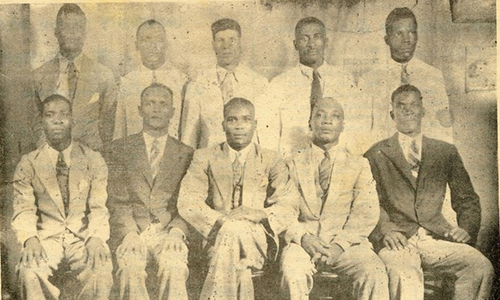
In the post-Emancipation society, labourers were being paid wages for the first time and needed to find ways to ensure they saved for future needs. A number of individuals, often labourers with entrepreneurial skills found ways of starting saving schemes.
By the mid-1840s this was arousing the concerns of the Administration as there was no regulation about how these schemes should be managed and it was suspected that they were designed to deprive labourers of their earnings. In 1847, the local government created its Savings Bank although it did not become functional till some years later. However, the fact that planters and merchants were involved in the management of the Bank could not have endeared the institution to the labourers.
Friendly societies, or benevolent associations were often the answer to this problem. In 1854 Richard Davoren and Samuel Berridge submitted a report to the Board of Council on the Friendly Societies in existence at the time. It showed the fluidity of these organisations and the very amateurish way in which they were run. The Society associated with St. George’s Church had once had a membership of 500. It had been reduced to 155 at the time of the report. They had deposited funds in Colonial Bank which they had used for charitable work and to repair the church. The report rightly viewed this as inappropriate use of funds. The two men had been unable to acquire copies of the rules of the society despite repeated requests. Another Society had been in existence in St. Peter’s but information concerning it had been in the memory of the late rector. It too had placed funds in Colonial bank. Its rules demonstrated a lack of security in dealing with funds, the unfettered power of patrons to expel members and the lack of an appeal process for such expelled members
Friendly Societies were made up of a group of persons who joined together for a common financial or social purpose. Their goals went further than the partner-hand which was often of short duration. Their membership paid a certain amount every week to a treasurer. The sums collected helped finance contributions towards the cost of funerals and to help in times of sickness. Workers worried about how they would cope when such personal calamities struck. By pooling together the resources of a large number of members, they were able to provide some relief in times of stress.
In the 20th century the major groups were
- The Heart and Hand
Was founded in 1909 by John Warner of Cayon who was shocked by the sight of a pauper’s funeral and formed the society to make sure that such events would be kept to a minimum. After a slump in membership, the leadership of the organisation was taken over by Warner’s nephew, Icen Wharton. Along with his collegues he worked hard to motivate people to join and in 1959 when the society celebrated its 50th Anniversary, the Heart and Hand had 1700 members and three halls.
- The Unity Friendly Society also known as the Black and White
Was formed on the 28 Fen 1932 by eleven young men from the villages of Haynes Smith and Russell. Its main driving force was Charles W Huggins, its first President. Walter Cotton was its Secretary and Vernon Wilkes was its Treasurer. The other members of the founding group were Edward Berkeley, Edward Magro, Henry Payne, Ezekiel Osborne, Thomas Lester, Alan Adams, and James Webbe. The organisation was still going still functioning in 1982 when it celebrated its 50th anniversary.
- The Eastern Benevolent Society
Still operates a funeral home.
The Benevolent or Friendly Societies tended to follow the example of the Masonic lodges and adopted some of the paraphernalia often parading at funerals. This helped to show solidarity of membership and attract new members who would then become aware of the benefits that the society provided. But while the Masonic lodges had an exclusively male membership that was mostly white or at least upper class, the benevolent societies attracted black membership and included women. Even the “Union” or as it was officially called, the Universal Benevolent Association catered for sickness and funeral relief, but its focus remained on working conditions. The tradition was carried forward into the Trades and Labour Union when it was founded in 1940.
In 1967 government launched the National Provident Fund. This was the start of the social safety net that was to become Social Security. Contributions to the Fund were made through deductions to wages. It was not a voluntary membership. Ten years later it merged into a bigger Social Security. Soon after its inception, the SS Board started providing a sickness benefit, and a funeral grant. Other benefits were added over time and to assist people during financially stressful times in their lives. This has resulted in the diminished importance of the Benevolent Societies and their eventual disappearance.
vFounders of the Unity Friendly Society




